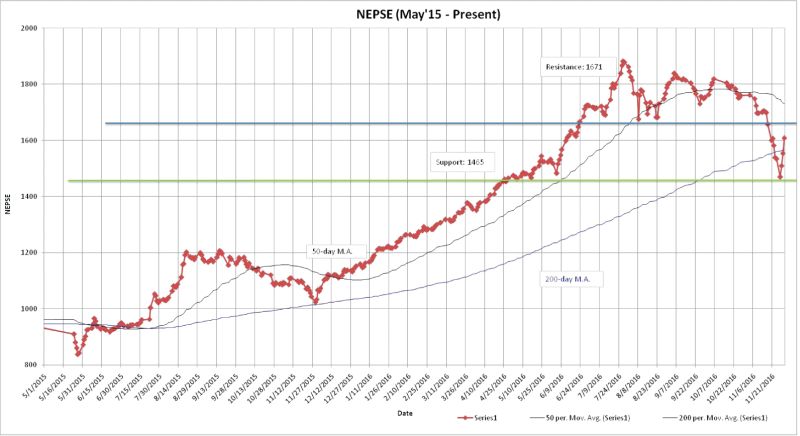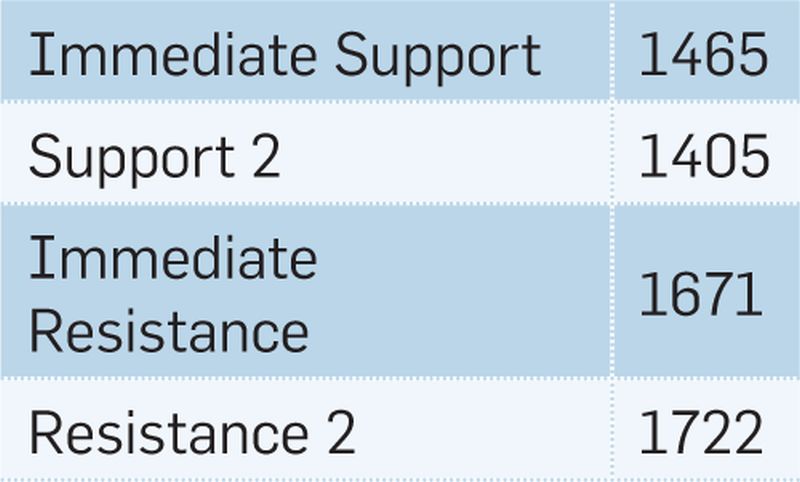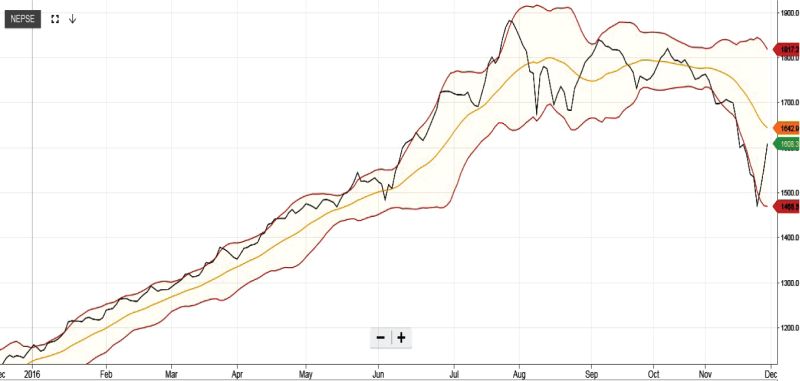Notice (8): Trying to access array offset on value of type null [APP/View/MagazineArticles/view.ctp, line 54]Code Context $user = $this->Session->read('Auth.User');
//find the group of logged user
$groupId = $user['Group']['id'];
$viewFile = '/var/www/html/newbusinessage.com/app/View/MagazineArticles/view.ctp'
$dataForView = array(
'magazineArticle' => array(
'MagazineArticle' => array(
'id' => '1650',
'magazine_issue_id' => '968',
'magazine_category_id' => '63',
'title' => 'Monthly Technical Analysis of Nepse (3 November to 30 November 2016)',
'image' => null,
'short_content' => 'The benchmark index experienced high volatility and bearish downturn in the course of last month. The index lost a staggering 151.38 points (or down 8.60%) to close at 1608.33. ',
'content' => '<p style="text-align:justify"><span style="font-size:20px"><strong>High Volatility</strong></span><br />
<img alt="" src="/userfiles/images/st%2811%29.jpg" style="height:432px; margin-left:10px; margin-right:10px; width:800px" /></p>
<p style="text-align:justify"><img alt="" src="/userfiles/images/st1%2811%29.jpg" style="height:436px; margin-left:10px; margin-right:10px; width:800px" /></p>
<p style="text-align:justify"><span style="font-size:16px"><strong>Trend Analysis</strong></span><br />
The benchmark index experienced high volatility and bearish downturn in the course of last month. The index lost a staggering 151.38 points (or down 8.60%) to close at 1608.33. Nepse crossed below the 50-day moving average towards the beginning of last month, only to fall below the 200-day moving average closer towards the end of last month. Various reasons relating to liquidity, currency, and political instability may have influenced the market to go bearish. The average volume turnover increased to NPR 95.24 crores compared to NPR 81.70 crores the month prior. </p>
<p style="text-align:justify"><img alt="" src="/userfiles/images/st3%286%29.jpg" style="height:158px; margin-left:10px; margin-right:10px; width:800px" /></p>
<p style="text-align:justify"><span style="font-size:16px"><strong>Resistance and Support</strong></span></p>
<p style="text-align:justify"><span style="font-size:16px"><strong><img alt="" src="/userfiles/images/st2%2812%29.jpg" style="height:482px; margin-left:10px; margin-right:10px; width:800px" /></strong></span></p>
<p style="text-align:justify">The benchmark index broke the support level of 1730 at the beginning of last month. In the course of the month, the index went down as close to 1400 level, signifying a speculative and bearish momentum in the market. As high volatility looms over the market, the index could see some speculative bullish or bearish run in days to come. The new support and resistance level stands at 1465 and 1671 respectively. </p>
<p style="text-align:justify"><img alt="" src="/userfiles/images/st4%285%29.jpg" style="height:129px; margin-left:10px; margin-right:10px; width:800px" /></p>
<p style="text-align:justify"><span style="font-size:16px"><strong>Nepse Trend Indicator</strong></span><br />
<strong>a. MACD</strong><br />
The MACD is a momentum oscillator formed by using two different types of moving averages, which provides specific buying or selling signals. When a MACD line crosses above the signal line, it is considered to be a positive sign and indicates a time to buy, and vice-versa. </p>
<p style="text-align:justify">The MACD and the signal line, at the beginning of the month, stood at -4.53 and -0.37 respectively. Both the lines continued to fall for majority of last month. However, towards the end of the month, both macd and signal line climbed up to close at -57.68 and -51.73 respectively. The macd indicator remained bearish throughout last month. However the recent turn in the macd line could signal a possibly bullish trigger.</p>
<p style="text-align:justify"><strong>b. RSI</strong><br />
RSI is a form of leading indicator that is believed to be most effective during periods of sideways movement. Such indicators may create numerous buy and sell signals that are useful when the market is not clearly trending upwards or downwards. </p>
<p style="text-align:justify">The RSI, at the beginning of last month, stood at 44.86 level. In the course of the month, it changed by 1.04 points to close at 43.82 level. The RSI remained below the 30’s zone for majority of last month, indicating high selling pressure. The recent rise in RSI level could signal a decrease in selling pressure in the market.</p>
<p style="text-align:justify"><strong>c. Bollinger Bands</strong><br />
The Bollinger Band is a technical indicator that consists of a moving average (21-day) along with two trading bands above (upper band) and below it (lower band). The bands are an indication of volatility, which are represented by calculating standard deviation. </p>
<p style="text-align:justify">The benchmark index hovered closer to, if not below, the lower bollinger band in the course of last month, signifying oversold condition in the market. Towards the end of the month, the index climbed up and near middle bollinger band, which could mean a slowdown in selling pressure. However, the distance between the upper and lower bands remains wide, signifying high market volatility.</p>
<p style="text-align:justify"><img alt="" src="/userfiles/images/st5%281%29.jpg" style="height:381px; width:800px" /></p>
<p style="text-align:justify"><span style="font-size:16px"><strong>Overview</strong></span><br />
The benchmark index declined by 151.38 points (or down 8.60%) to close at 1608.33 last month. After moving sideways for past few months, the index took a bearish run last month. The bearish run was further supported when Nepse crossed below the 200-day moving average. The technical indicators show signs of improvement in selling pressure in the market. The macd and the signal closed at -57.68 and -51.73 respectively. The RSI has climbed out of the oversold zone to close at 43.82 level. The bollinger bands show presence of high market volatility. The new support and resistance level now stands at 1465 and 1671 level respectively.</p>
',
'status' => true,
'publish_date' => '0000-00-00',
'created' => '2016-12-12 15:07:19',
'modified' => '2016-12-12 15:21:32',
'keywords' => '',
'description' => '',
'sortorder' => '1611',
'feature_article' => true,
'user_id' => '11',
'image1' => null,
'image2' => null,
'image3' => null,
'image4' => null
),
'MagazineIssue' => array(
'id' => '968',
'image' => '20161211023405_cover.JPG',
'sortorder' => '1517',
'published' => true,
'created' => '2016-12-11 14:34:06',
'modified' => '2016-12-12 14:40:56',
'title' => 'December 2016',
'publish_date' => '2016-12-01',
'parent_id' => '0',
'homepage' => true,
'user_id' => '11'
),
'MagazineCategory' => array(
'id' => '63',
'title' => 'Stock Taking',
'sortorder' => '516',
'status' => true,
'created' => '0000-00-00 00:00:00',
'homepage' => true,
'modified' => '2013-04-01 00:00:00'
),
'User' => array(
'password' => '*****',
'id' => '11',
'user_detail_id' => '0',
'group_id' => '24',
'username' => 'nsingha@abhiyan.com.np',
'name' => '',
'email' => 'nsingha@abhiyan.com.np',
'address' => '',
'gender' => '',
'access' => '1',
'phone' => '',
'access_type' => '0',
'activated' => false,
'sortorder' => '0',
'published' => '0',
'created' => '2015-04-08 13:22:59',
'last_login' => '2023-04-16 09:29:47',
'ip' => '172.69.77.43'
),
'MagazineArticleComment' => array(),
'MagazineView' => array(
(int) 0 => array(
[maximum depth reached]
)
)
),
'current_user' => null,
'logged_in' => false
)
$magazineArticle = array(
'MagazineArticle' => array(
'id' => '1650',
'magazine_issue_id' => '968',
'magazine_category_id' => '63',
'title' => 'Monthly Technical Analysis of Nepse (3 November to 30 November 2016)',
'image' => null,
'short_content' => 'The benchmark index experienced high volatility and bearish downturn in the course of last month. The index lost a staggering 151.38 points (or down 8.60%) to close at 1608.33. ',
'content' => '<p style="text-align:justify"><span style="font-size:20px"><strong>High Volatility</strong></span><br />
<img alt="" src="/userfiles/images/st%2811%29.jpg" style="height:432px; margin-left:10px; margin-right:10px; width:800px" /></p>
<p style="text-align:justify"><img alt="" src="/userfiles/images/st1%2811%29.jpg" style="height:436px; margin-left:10px; margin-right:10px; width:800px" /></p>
<p style="text-align:justify"><span style="font-size:16px"><strong>Trend Analysis</strong></span><br />
The benchmark index experienced high volatility and bearish downturn in the course of last month. The index lost a staggering 151.38 points (or down 8.60%) to close at 1608.33. Nepse crossed below the 50-day moving average towards the beginning of last month, only to fall below the 200-day moving average closer towards the end of last month. Various reasons relating to liquidity, currency, and political instability may have influenced the market to go bearish. The average volume turnover increased to NPR 95.24 crores compared to NPR 81.70 crores the month prior. </p>
<p style="text-align:justify"><img alt="" src="/userfiles/images/st3%286%29.jpg" style="height:158px; margin-left:10px; margin-right:10px; width:800px" /></p>
<p style="text-align:justify"><span style="font-size:16px"><strong>Resistance and Support</strong></span></p>
<p style="text-align:justify"><span style="font-size:16px"><strong><img alt="" src="/userfiles/images/st2%2812%29.jpg" style="height:482px; margin-left:10px; margin-right:10px; width:800px" /></strong></span></p>
<p style="text-align:justify">The benchmark index broke the support level of 1730 at the beginning of last month. In the course of the month, the index went down as close to 1400 level, signifying a speculative and bearish momentum in the market. As high volatility looms over the market, the index could see some speculative bullish or bearish run in days to come. The new support and resistance level stands at 1465 and 1671 respectively. </p>
<p style="text-align:justify"><img alt="" src="/userfiles/images/st4%285%29.jpg" style="height:129px; margin-left:10px; margin-right:10px; width:800px" /></p>
<p style="text-align:justify"><span style="font-size:16px"><strong>Nepse Trend Indicator</strong></span><br />
<strong>a. MACD</strong><br />
The MACD is a momentum oscillator formed by using two different types of moving averages, which provides specific buying or selling signals. When a MACD line crosses above the signal line, it is considered to be a positive sign and indicates a time to buy, and vice-versa. </p>
<p style="text-align:justify">The MACD and the signal line, at the beginning of the month, stood at -4.53 and -0.37 respectively. Both the lines continued to fall for majority of last month. However, towards the end of the month, both macd and signal line climbed up to close at -57.68 and -51.73 respectively. The macd indicator remained bearish throughout last month. However the recent turn in the macd line could signal a possibly bullish trigger.</p>
<p style="text-align:justify"><strong>b. RSI</strong><br />
RSI is a form of leading indicator that is believed to be most effective during periods of sideways movement. Such indicators may create numerous buy and sell signals that are useful when the market is not clearly trending upwards or downwards. </p>
<p style="text-align:justify">The RSI, at the beginning of last month, stood at 44.86 level. In the course of the month, it changed by 1.04 points to close at 43.82 level. The RSI remained below the 30’s zone for majority of last month, indicating high selling pressure. The recent rise in RSI level could signal a decrease in selling pressure in the market.</p>
<p style="text-align:justify"><strong>c. Bollinger Bands</strong><br />
The Bollinger Band is a technical indicator that consists of a moving average (21-day) along with two trading bands above (upper band) and below it (lower band). The bands are an indication of volatility, which are represented by calculating standard deviation. </p>
<p style="text-align:justify">The benchmark index hovered closer to, if not below, the lower bollinger band in the course of last month, signifying oversold condition in the market. Towards the end of the month, the index climbed up and near middle bollinger band, which could mean a slowdown in selling pressure. However, the distance between the upper and lower bands remains wide, signifying high market volatility.</p>
<p style="text-align:justify"><img alt="" src="/userfiles/images/st5%281%29.jpg" style="height:381px; width:800px" /></p>
<p style="text-align:justify"><span style="font-size:16px"><strong>Overview</strong></span><br />
The benchmark index declined by 151.38 points (or down 8.60%) to close at 1608.33 last month. After moving sideways for past few months, the index took a bearish run last month. The bearish run was further supported when Nepse crossed below the 200-day moving average. The technical indicators show signs of improvement in selling pressure in the market. The macd and the signal closed at -57.68 and -51.73 respectively. The RSI has climbed out of the oversold zone to close at 43.82 level. The bollinger bands show presence of high market volatility. The new support and resistance level now stands at 1465 and 1671 level respectively.</p>
',
'status' => true,
'publish_date' => '0000-00-00',
'created' => '2016-12-12 15:07:19',
'modified' => '2016-12-12 15:21:32',
'keywords' => '',
'description' => '',
'sortorder' => '1611',
'feature_article' => true,
'user_id' => '11',
'image1' => null,
'image2' => null,
'image3' => null,
'image4' => null
),
'MagazineIssue' => array(
'id' => '968',
'image' => '20161211023405_cover.JPG',
'sortorder' => '1517',
'published' => true,
'created' => '2016-12-11 14:34:06',
'modified' => '2016-12-12 14:40:56',
'title' => 'December 2016',
'publish_date' => '2016-12-01',
'parent_id' => '0',
'homepage' => true,
'user_id' => '11'
),
'MagazineCategory' => array(
'id' => '63',
'title' => 'Stock Taking',
'sortorder' => '516',
'status' => true,
'created' => '0000-00-00 00:00:00',
'homepage' => true,
'modified' => '2013-04-01 00:00:00'
),
'User' => array(
'password' => '*****',
'id' => '11',
'user_detail_id' => '0',
'group_id' => '24',
'username' => 'nsingha@abhiyan.com.np',
'name' => '',
'email' => 'nsingha@abhiyan.com.np',
'address' => '',
'gender' => '',
'access' => '1',
'phone' => '',
'access_type' => '0',
'activated' => false,
'sortorder' => '0',
'published' => '0',
'created' => '2015-04-08 13:22:59',
'last_login' => '2023-04-16 09:29:47',
'ip' => '172.69.77.43'
),
'MagazineArticleComment' => array(),
'MagazineView' => array(
(int) 0 => array(
'magazine_article_id' => '1650',
'hit' => '4160'
)
)
)
$current_user = null
$logged_in = false
$user = null
include - APP/View/MagazineArticles/view.ctp, line 54
View::_evaluate() - CORE/Cake/View/View.php, line 971
View::_render() - CORE/Cake/View/View.php, line 933
View::render() - CORE/Cake/View/View.php, line 473
Controller::render() - CORE/Cake/Controller/Controller.php, line 968
Dispatcher::_invoke() - CORE/Cake/Routing/Dispatcher.php, line 200
Dispatcher::dispatch() - CORE/Cake/Routing/Dispatcher.php, line 167
[main] - APP/webroot/index.php, line 117
Notice (8): Trying to access array offset on value of type null [APP/View/MagazineArticles/view.ctp, line 54]Code Context $user = $this->Session->read('Auth.User');
//find the group of logged user
$groupId = $user['Group']['id'];
$viewFile = '/var/www/html/newbusinessage.com/app/View/MagazineArticles/view.ctp'
$dataForView = array(
'magazineArticle' => array(
'MagazineArticle' => array(
'id' => '1650',
'magazine_issue_id' => '968',
'magazine_category_id' => '63',
'title' => 'Monthly Technical Analysis of Nepse (3 November to 30 November 2016)',
'image' => null,
'short_content' => 'The benchmark index experienced high volatility and bearish downturn in the course of last month. The index lost a staggering 151.38 points (or down 8.60%) to close at 1608.33. ',
'content' => '<p style="text-align:justify"><span style="font-size:20px"><strong>High Volatility</strong></span><br />
<img alt="" src="/userfiles/images/st%2811%29.jpg" style="height:432px; margin-left:10px; margin-right:10px; width:800px" /></p>
<p style="text-align:justify"><img alt="" src="/userfiles/images/st1%2811%29.jpg" style="height:436px; margin-left:10px; margin-right:10px; width:800px" /></p>
<p style="text-align:justify"><span style="font-size:16px"><strong>Trend Analysis</strong></span><br />
The benchmark index experienced high volatility and bearish downturn in the course of last month. The index lost a staggering 151.38 points (or down 8.60%) to close at 1608.33. Nepse crossed below the 50-day moving average towards the beginning of last month, only to fall below the 200-day moving average closer towards the end of last month. Various reasons relating to liquidity, currency, and political instability may have influenced the market to go bearish. The average volume turnover increased to NPR 95.24 crores compared to NPR 81.70 crores the month prior. </p>
<p style="text-align:justify"><img alt="" src="/userfiles/images/st3%286%29.jpg" style="height:158px; margin-left:10px; margin-right:10px; width:800px" /></p>
<p style="text-align:justify"><span style="font-size:16px"><strong>Resistance and Support</strong></span></p>
<p style="text-align:justify"><span style="font-size:16px"><strong><img alt="" src="/userfiles/images/st2%2812%29.jpg" style="height:482px; margin-left:10px; margin-right:10px; width:800px" /></strong></span></p>
<p style="text-align:justify">The benchmark index broke the support level of 1730 at the beginning of last month. In the course of the month, the index went down as close to 1400 level, signifying a speculative and bearish momentum in the market. As high volatility looms over the market, the index could see some speculative bullish or bearish run in days to come. The new support and resistance level stands at 1465 and 1671 respectively. </p>
<p style="text-align:justify"><img alt="" src="/userfiles/images/st4%285%29.jpg" style="height:129px; margin-left:10px; margin-right:10px; width:800px" /></p>
<p style="text-align:justify"><span style="font-size:16px"><strong>Nepse Trend Indicator</strong></span><br />
<strong>a. MACD</strong><br />
The MACD is a momentum oscillator formed by using two different types of moving averages, which provides specific buying or selling signals. When a MACD line crosses above the signal line, it is considered to be a positive sign and indicates a time to buy, and vice-versa. </p>
<p style="text-align:justify">The MACD and the signal line, at the beginning of the month, stood at -4.53 and -0.37 respectively. Both the lines continued to fall for majority of last month. However, towards the end of the month, both macd and signal line climbed up to close at -57.68 and -51.73 respectively. The macd indicator remained bearish throughout last month. However the recent turn in the macd line could signal a possibly bullish trigger.</p>
<p style="text-align:justify"><strong>b. RSI</strong><br />
RSI is a form of leading indicator that is believed to be most effective during periods of sideways movement. Such indicators may create numerous buy and sell signals that are useful when the market is not clearly trending upwards or downwards. </p>
<p style="text-align:justify">The RSI, at the beginning of last month, stood at 44.86 level. In the course of the month, it changed by 1.04 points to close at 43.82 level. The RSI remained below the 30’s zone for majority of last month, indicating high selling pressure. The recent rise in RSI level could signal a decrease in selling pressure in the market.</p>
<p style="text-align:justify"><strong>c. Bollinger Bands</strong><br />
The Bollinger Band is a technical indicator that consists of a moving average (21-day) along with two trading bands above (upper band) and below it (lower band). The bands are an indication of volatility, which are represented by calculating standard deviation. </p>
<p style="text-align:justify">The benchmark index hovered closer to, if not below, the lower bollinger band in the course of last month, signifying oversold condition in the market. Towards the end of the month, the index climbed up and near middle bollinger band, which could mean a slowdown in selling pressure. However, the distance between the upper and lower bands remains wide, signifying high market volatility.</p>
<p style="text-align:justify"><img alt="" src="/userfiles/images/st5%281%29.jpg" style="height:381px; width:800px" /></p>
<p style="text-align:justify"><span style="font-size:16px"><strong>Overview</strong></span><br />
The benchmark index declined by 151.38 points (or down 8.60%) to close at 1608.33 last month. After moving sideways for past few months, the index took a bearish run last month. The bearish run was further supported when Nepse crossed below the 200-day moving average. The technical indicators show signs of improvement in selling pressure in the market. The macd and the signal closed at -57.68 and -51.73 respectively. The RSI has climbed out of the oversold zone to close at 43.82 level. The bollinger bands show presence of high market volatility. The new support and resistance level now stands at 1465 and 1671 level respectively.</p>
',
'status' => true,
'publish_date' => '0000-00-00',
'created' => '2016-12-12 15:07:19',
'modified' => '2016-12-12 15:21:32',
'keywords' => '',
'description' => '',
'sortorder' => '1611',
'feature_article' => true,
'user_id' => '11',
'image1' => null,
'image2' => null,
'image3' => null,
'image4' => null
),
'MagazineIssue' => array(
'id' => '968',
'image' => '20161211023405_cover.JPG',
'sortorder' => '1517',
'published' => true,
'created' => '2016-12-11 14:34:06',
'modified' => '2016-12-12 14:40:56',
'title' => 'December 2016',
'publish_date' => '2016-12-01',
'parent_id' => '0',
'homepage' => true,
'user_id' => '11'
),
'MagazineCategory' => array(
'id' => '63',
'title' => 'Stock Taking',
'sortorder' => '516',
'status' => true,
'created' => '0000-00-00 00:00:00',
'homepage' => true,
'modified' => '2013-04-01 00:00:00'
),
'User' => array(
'password' => '*****',
'id' => '11',
'user_detail_id' => '0',
'group_id' => '24',
'username' => 'nsingha@abhiyan.com.np',
'name' => '',
'email' => 'nsingha@abhiyan.com.np',
'address' => '',
'gender' => '',
'access' => '1',
'phone' => '',
'access_type' => '0',
'activated' => false,
'sortorder' => '0',
'published' => '0',
'created' => '2015-04-08 13:22:59',
'last_login' => '2023-04-16 09:29:47',
'ip' => '172.69.77.43'
),
'MagazineArticleComment' => array(),
'MagazineView' => array(
(int) 0 => array(
[maximum depth reached]
)
)
),
'current_user' => null,
'logged_in' => false
)
$magazineArticle = array(
'MagazineArticle' => array(
'id' => '1650',
'magazine_issue_id' => '968',
'magazine_category_id' => '63',
'title' => 'Monthly Technical Analysis of Nepse (3 November to 30 November 2016)',
'image' => null,
'short_content' => 'The benchmark index experienced high volatility and bearish downturn in the course of last month. The index lost a staggering 151.38 points (or down 8.60%) to close at 1608.33. ',
'content' => '<p style="text-align:justify"><span style="font-size:20px"><strong>High Volatility</strong></span><br />
<img alt="" src="/userfiles/images/st%2811%29.jpg" style="height:432px; margin-left:10px; margin-right:10px; width:800px" /></p>
<p style="text-align:justify"><img alt="" src="/userfiles/images/st1%2811%29.jpg" style="height:436px; margin-left:10px; margin-right:10px; width:800px" /></p>
<p style="text-align:justify"><span style="font-size:16px"><strong>Trend Analysis</strong></span><br />
The benchmark index experienced high volatility and bearish downturn in the course of last month. The index lost a staggering 151.38 points (or down 8.60%) to close at 1608.33. Nepse crossed below the 50-day moving average towards the beginning of last month, only to fall below the 200-day moving average closer towards the end of last month. Various reasons relating to liquidity, currency, and political instability may have influenced the market to go bearish. The average volume turnover increased to NPR 95.24 crores compared to NPR 81.70 crores the month prior. </p>
<p style="text-align:justify"><img alt="" src="/userfiles/images/st3%286%29.jpg" style="height:158px; margin-left:10px; margin-right:10px; width:800px" /></p>
<p style="text-align:justify"><span style="font-size:16px"><strong>Resistance and Support</strong></span></p>
<p style="text-align:justify"><span style="font-size:16px"><strong><img alt="" src="/userfiles/images/st2%2812%29.jpg" style="height:482px; margin-left:10px; margin-right:10px; width:800px" /></strong></span></p>
<p style="text-align:justify">The benchmark index broke the support level of 1730 at the beginning of last month. In the course of the month, the index went down as close to 1400 level, signifying a speculative and bearish momentum in the market. As high volatility looms over the market, the index could see some speculative bullish or bearish run in days to come. The new support and resistance level stands at 1465 and 1671 respectively. </p>
<p style="text-align:justify"><img alt="" src="/userfiles/images/st4%285%29.jpg" style="height:129px; margin-left:10px; margin-right:10px; width:800px" /></p>
<p style="text-align:justify"><span style="font-size:16px"><strong>Nepse Trend Indicator</strong></span><br />
<strong>a. MACD</strong><br />
The MACD is a momentum oscillator formed by using two different types of moving averages, which provides specific buying or selling signals. When a MACD line crosses above the signal line, it is considered to be a positive sign and indicates a time to buy, and vice-versa. </p>
<p style="text-align:justify">The MACD and the signal line, at the beginning of the month, stood at -4.53 and -0.37 respectively. Both the lines continued to fall for majority of last month. However, towards the end of the month, both macd and signal line climbed up to close at -57.68 and -51.73 respectively. The macd indicator remained bearish throughout last month. However the recent turn in the macd line could signal a possibly bullish trigger.</p>
<p style="text-align:justify"><strong>b. RSI</strong><br />
RSI is a form of leading indicator that is believed to be most effective during periods of sideways movement. Such indicators may create numerous buy and sell signals that are useful when the market is not clearly trending upwards or downwards. </p>
<p style="text-align:justify">The RSI, at the beginning of last month, stood at 44.86 level. In the course of the month, it changed by 1.04 points to close at 43.82 level. The RSI remained below the 30’s zone for majority of last month, indicating high selling pressure. The recent rise in RSI level could signal a decrease in selling pressure in the market.</p>
<p style="text-align:justify"><strong>c. Bollinger Bands</strong><br />
The Bollinger Band is a technical indicator that consists of a moving average (21-day) along with two trading bands above (upper band) and below it (lower band). The bands are an indication of volatility, which are represented by calculating standard deviation. </p>
<p style="text-align:justify">The benchmark index hovered closer to, if not below, the lower bollinger band in the course of last month, signifying oversold condition in the market. Towards the end of the month, the index climbed up and near middle bollinger band, which could mean a slowdown in selling pressure. However, the distance between the upper and lower bands remains wide, signifying high market volatility.</p>
<p style="text-align:justify"><img alt="" src="/userfiles/images/st5%281%29.jpg" style="height:381px; width:800px" /></p>
<p style="text-align:justify"><span style="font-size:16px"><strong>Overview</strong></span><br />
The benchmark index declined by 151.38 points (or down 8.60%) to close at 1608.33 last month. After moving sideways for past few months, the index took a bearish run last month. The bearish run was further supported when Nepse crossed below the 200-day moving average. The technical indicators show signs of improvement in selling pressure in the market. The macd and the signal closed at -57.68 and -51.73 respectively. The RSI has climbed out of the oversold zone to close at 43.82 level. The bollinger bands show presence of high market volatility. The new support and resistance level now stands at 1465 and 1671 level respectively.</p>
',
'status' => true,
'publish_date' => '0000-00-00',
'created' => '2016-12-12 15:07:19',
'modified' => '2016-12-12 15:21:32',
'keywords' => '',
'description' => '',
'sortorder' => '1611',
'feature_article' => true,
'user_id' => '11',
'image1' => null,
'image2' => null,
'image3' => null,
'image4' => null
),
'MagazineIssue' => array(
'id' => '968',
'image' => '20161211023405_cover.JPG',
'sortorder' => '1517',
'published' => true,
'created' => '2016-12-11 14:34:06',
'modified' => '2016-12-12 14:40:56',
'title' => 'December 2016',
'publish_date' => '2016-12-01',
'parent_id' => '0',
'homepage' => true,
'user_id' => '11'
),
'MagazineCategory' => array(
'id' => '63',
'title' => 'Stock Taking',
'sortorder' => '516',
'status' => true,
'created' => '0000-00-00 00:00:00',
'homepage' => true,
'modified' => '2013-04-01 00:00:00'
),
'User' => array(
'password' => '*****',
'id' => '11',
'user_detail_id' => '0',
'group_id' => '24',
'username' => 'nsingha@abhiyan.com.np',
'name' => '',
'email' => 'nsingha@abhiyan.com.np',
'address' => '',
'gender' => '',
'access' => '1',
'phone' => '',
'access_type' => '0',
'activated' => false,
'sortorder' => '0',
'published' => '0',
'created' => '2015-04-08 13:22:59',
'last_login' => '2023-04-16 09:29:47',
'ip' => '172.69.77.43'
),
'MagazineArticleComment' => array(),
'MagazineView' => array(
(int) 0 => array(
'magazine_article_id' => '1650',
'hit' => '4160'
)
)
)
$current_user = null
$logged_in = false
$user = null
include - APP/View/MagazineArticles/view.ctp, line 54
View::_evaluate() - CORE/Cake/View/View.php, line 971
View::_render() - CORE/Cake/View/View.php, line 933
View::render() - CORE/Cake/View/View.php, line 473
Controller::render() - CORE/Cake/Controller/Controller.php, line 968
Dispatcher::_invoke() - CORE/Cake/Routing/Dispatcher.php, line 200
Dispatcher::dispatch() - CORE/Cake/Routing/Dispatcher.php, line 167
[main] - APP/webroot/index.php, line 117
Notice (8): Trying to access array offset on value of type null [APP/View/MagazineArticles/view.ctp, line 55]Code Context //find the group of logged user
$groupId = $user['Group']['id'];
$user_id=$user["id"];
$viewFile = '/var/www/html/newbusinessage.com/app/View/MagazineArticles/view.ctp'
$dataForView = array(
'magazineArticle' => array(
'MagazineArticle' => array(
'id' => '1650',
'magazine_issue_id' => '968',
'magazine_category_id' => '63',
'title' => 'Monthly Technical Analysis of Nepse (3 November to 30 November 2016)',
'image' => null,
'short_content' => 'The benchmark index experienced high volatility and bearish downturn in the course of last month. The index lost a staggering 151.38 points (or down 8.60%) to close at 1608.33. ',
'content' => '<p style="text-align:justify"><span style="font-size:20px"><strong>High Volatility</strong></span><br />
<img alt="" src="/userfiles/images/st%2811%29.jpg" style="height:432px; margin-left:10px; margin-right:10px; width:800px" /></p>
<p style="text-align:justify"><img alt="" src="/userfiles/images/st1%2811%29.jpg" style="height:436px; margin-left:10px; margin-right:10px; width:800px" /></p>
<p style="text-align:justify"><span style="font-size:16px"><strong>Trend Analysis</strong></span><br />
The benchmark index experienced high volatility and bearish downturn in the course of last month. The index lost a staggering 151.38 points (or down 8.60%) to close at 1608.33. Nepse crossed below the 50-day moving average towards the beginning of last month, only to fall below the 200-day moving average closer towards the end of last month. Various reasons relating to liquidity, currency, and political instability may have influenced the market to go bearish. The average volume turnover increased to NPR 95.24 crores compared to NPR 81.70 crores the month prior. </p>
<p style="text-align:justify"><img alt="" src="/userfiles/images/st3%286%29.jpg" style="height:158px; margin-left:10px; margin-right:10px; width:800px" /></p>
<p style="text-align:justify"><span style="font-size:16px"><strong>Resistance and Support</strong></span></p>
<p style="text-align:justify"><span style="font-size:16px"><strong><img alt="" src="/userfiles/images/st2%2812%29.jpg" style="height:482px; margin-left:10px; margin-right:10px; width:800px" /></strong></span></p>
<p style="text-align:justify">The benchmark index broke the support level of 1730 at the beginning of last month. In the course of the month, the index went down as close to 1400 level, signifying a speculative and bearish momentum in the market. As high volatility looms over the market, the index could see some speculative bullish or bearish run in days to come. The new support and resistance level stands at 1465 and 1671 respectively. </p>
<p style="text-align:justify"><img alt="" src="/userfiles/images/st4%285%29.jpg" style="height:129px; margin-left:10px; margin-right:10px; width:800px" /></p>
<p style="text-align:justify"><span style="font-size:16px"><strong>Nepse Trend Indicator</strong></span><br />
<strong>a. MACD</strong><br />
The MACD is a momentum oscillator formed by using two different types of moving averages, which provides specific buying or selling signals. When a MACD line crosses above the signal line, it is considered to be a positive sign and indicates a time to buy, and vice-versa. </p>
<p style="text-align:justify">The MACD and the signal line, at the beginning of the month, stood at -4.53 and -0.37 respectively. Both the lines continued to fall for majority of last month. However, towards the end of the month, both macd and signal line climbed up to close at -57.68 and -51.73 respectively. The macd indicator remained bearish throughout last month. However the recent turn in the macd line could signal a possibly bullish trigger.</p>
<p style="text-align:justify"><strong>b. RSI</strong><br />
RSI is a form of leading indicator that is believed to be most effective during periods of sideways movement. Such indicators may create numerous buy and sell signals that are useful when the market is not clearly trending upwards or downwards. </p>
<p style="text-align:justify">The RSI, at the beginning of last month, stood at 44.86 level. In the course of the month, it changed by 1.04 points to close at 43.82 level. The RSI remained below the 30’s zone for majority of last month, indicating high selling pressure. The recent rise in RSI level could signal a decrease in selling pressure in the market.</p>
<p style="text-align:justify"><strong>c. Bollinger Bands</strong><br />
The Bollinger Band is a technical indicator that consists of a moving average (21-day) along with two trading bands above (upper band) and below it (lower band). The bands are an indication of volatility, which are represented by calculating standard deviation. </p>
<p style="text-align:justify">The benchmark index hovered closer to, if not below, the lower bollinger band in the course of last month, signifying oversold condition in the market. Towards the end of the month, the index climbed up and near middle bollinger band, which could mean a slowdown in selling pressure. However, the distance between the upper and lower bands remains wide, signifying high market volatility.</p>
<p style="text-align:justify"><img alt="" src="/userfiles/images/st5%281%29.jpg" style="height:381px; width:800px" /></p>
<p style="text-align:justify"><span style="font-size:16px"><strong>Overview</strong></span><br />
The benchmark index declined by 151.38 points (or down 8.60%) to close at 1608.33 last month. After moving sideways for past few months, the index took a bearish run last month. The bearish run was further supported when Nepse crossed below the 200-day moving average. The technical indicators show signs of improvement in selling pressure in the market. The macd and the signal closed at -57.68 and -51.73 respectively. The RSI has climbed out of the oversold zone to close at 43.82 level. The bollinger bands show presence of high market volatility. The new support and resistance level now stands at 1465 and 1671 level respectively.</p>
',
'status' => true,
'publish_date' => '0000-00-00',
'created' => '2016-12-12 15:07:19',
'modified' => '2016-12-12 15:21:32',
'keywords' => '',
'description' => '',
'sortorder' => '1611',
'feature_article' => true,
'user_id' => '11',
'image1' => null,
'image2' => null,
'image3' => null,
'image4' => null
),
'MagazineIssue' => array(
'id' => '968',
'image' => '20161211023405_cover.JPG',
'sortorder' => '1517',
'published' => true,
'created' => '2016-12-11 14:34:06',
'modified' => '2016-12-12 14:40:56',
'title' => 'December 2016',
'publish_date' => '2016-12-01',
'parent_id' => '0',
'homepage' => true,
'user_id' => '11'
),
'MagazineCategory' => array(
'id' => '63',
'title' => 'Stock Taking',
'sortorder' => '516',
'status' => true,
'created' => '0000-00-00 00:00:00',
'homepage' => true,
'modified' => '2013-04-01 00:00:00'
),
'User' => array(
'password' => '*****',
'id' => '11',
'user_detail_id' => '0',
'group_id' => '24',
'username' => 'nsingha@abhiyan.com.np',
'name' => '',
'email' => 'nsingha@abhiyan.com.np',
'address' => '',
'gender' => '',
'access' => '1',
'phone' => '',
'access_type' => '0',
'activated' => false,
'sortorder' => '0',
'published' => '0',
'created' => '2015-04-08 13:22:59',
'last_login' => '2023-04-16 09:29:47',
'ip' => '172.69.77.43'
),
'MagazineArticleComment' => array(),
'MagazineView' => array(
(int) 0 => array(
[maximum depth reached]
)
)
),
'current_user' => null,
'logged_in' => false
)
$magazineArticle = array(
'MagazineArticle' => array(
'id' => '1650',
'magazine_issue_id' => '968',
'magazine_category_id' => '63',
'title' => 'Monthly Technical Analysis of Nepse (3 November to 30 November 2016)',
'image' => null,
'short_content' => 'The benchmark index experienced high volatility and bearish downturn in the course of last month. The index lost a staggering 151.38 points (or down 8.60%) to close at 1608.33. ',
'content' => '<p style="text-align:justify"><span style="font-size:20px"><strong>High Volatility</strong></span><br />
<img alt="" src="/userfiles/images/st%2811%29.jpg" style="height:432px; margin-left:10px; margin-right:10px; width:800px" /></p>
<p style="text-align:justify"><img alt="" src="/userfiles/images/st1%2811%29.jpg" style="height:436px; margin-left:10px; margin-right:10px; width:800px" /></p>
<p style="text-align:justify"><span style="font-size:16px"><strong>Trend Analysis</strong></span><br />
The benchmark index experienced high volatility and bearish downturn in the course of last month. The index lost a staggering 151.38 points (or down 8.60%) to close at 1608.33. Nepse crossed below the 50-day moving average towards the beginning of last month, only to fall below the 200-day moving average closer towards the end of last month. Various reasons relating to liquidity, currency, and political instability may have influenced the market to go bearish. The average volume turnover increased to NPR 95.24 crores compared to NPR 81.70 crores the month prior. </p>
<p style="text-align:justify"><img alt="" src="/userfiles/images/st3%286%29.jpg" style="height:158px; margin-left:10px; margin-right:10px; width:800px" /></p>
<p style="text-align:justify"><span style="font-size:16px"><strong>Resistance and Support</strong></span></p>
<p style="text-align:justify"><span style="font-size:16px"><strong><img alt="" src="/userfiles/images/st2%2812%29.jpg" style="height:482px; margin-left:10px; margin-right:10px; width:800px" /></strong></span></p>
<p style="text-align:justify">The benchmark index broke the support level of 1730 at the beginning of last month. In the course of the month, the index went down as close to 1400 level, signifying a speculative and bearish momentum in the market. As high volatility looms over the market, the index could see some speculative bullish or bearish run in days to come. The new support and resistance level stands at 1465 and 1671 respectively. </p>
<p style="text-align:justify"><img alt="" src="/userfiles/images/st4%285%29.jpg" style="height:129px; margin-left:10px; margin-right:10px; width:800px" /></p>
<p style="text-align:justify"><span style="font-size:16px"><strong>Nepse Trend Indicator</strong></span><br />
<strong>a. MACD</strong><br />
The MACD is a momentum oscillator formed by using two different types of moving averages, which provides specific buying or selling signals. When a MACD line crosses above the signal line, it is considered to be a positive sign and indicates a time to buy, and vice-versa. </p>
<p style="text-align:justify">The MACD and the signal line, at the beginning of the month, stood at -4.53 and -0.37 respectively. Both the lines continued to fall for majority of last month. However, towards the end of the month, both macd and signal line climbed up to close at -57.68 and -51.73 respectively. The macd indicator remained bearish throughout last month. However the recent turn in the macd line could signal a possibly bullish trigger.</p>
<p style="text-align:justify"><strong>b. RSI</strong><br />
RSI is a form of leading indicator that is believed to be most effective during periods of sideways movement. Such indicators may create numerous buy and sell signals that are useful when the market is not clearly trending upwards or downwards. </p>
<p style="text-align:justify">The RSI, at the beginning of last month, stood at 44.86 level. In the course of the month, it changed by 1.04 points to close at 43.82 level. The RSI remained below the 30’s zone for majority of last month, indicating high selling pressure. The recent rise in RSI level could signal a decrease in selling pressure in the market.</p>
<p style="text-align:justify"><strong>c. Bollinger Bands</strong><br />
The Bollinger Band is a technical indicator that consists of a moving average (21-day) along with two trading bands above (upper band) and below it (lower band). The bands are an indication of volatility, which are represented by calculating standard deviation. </p>
<p style="text-align:justify">The benchmark index hovered closer to, if not below, the lower bollinger band in the course of last month, signifying oversold condition in the market. Towards the end of the month, the index climbed up and near middle bollinger band, which could mean a slowdown in selling pressure. However, the distance between the upper and lower bands remains wide, signifying high market volatility.</p>
<p style="text-align:justify"><img alt="" src="/userfiles/images/st5%281%29.jpg" style="height:381px; width:800px" /></p>
<p style="text-align:justify"><span style="font-size:16px"><strong>Overview</strong></span><br />
The benchmark index declined by 151.38 points (or down 8.60%) to close at 1608.33 last month. After moving sideways for past few months, the index took a bearish run last month. The bearish run was further supported when Nepse crossed below the 200-day moving average. The technical indicators show signs of improvement in selling pressure in the market. The macd and the signal closed at -57.68 and -51.73 respectively. The RSI has climbed out of the oversold zone to close at 43.82 level. The bollinger bands show presence of high market volatility. The new support and resistance level now stands at 1465 and 1671 level respectively.</p>
',
'status' => true,
'publish_date' => '0000-00-00',
'created' => '2016-12-12 15:07:19',
'modified' => '2016-12-12 15:21:32',
'keywords' => '',
'description' => '',
'sortorder' => '1611',
'feature_article' => true,
'user_id' => '11',
'image1' => null,
'image2' => null,
'image3' => null,
'image4' => null
),
'MagazineIssue' => array(
'id' => '968',
'image' => '20161211023405_cover.JPG',
'sortorder' => '1517',
'published' => true,
'created' => '2016-12-11 14:34:06',
'modified' => '2016-12-12 14:40:56',
'title' => 'December 2016',
'publish_date' => '2016-12-01',
'parent_id' => '0',
'homepage' => true,
'user_id' => '11'
),
'MagazineCategory' => array(
'id' => '63',
'title' => 'Stock Taking',
'sortorder' => '516',
'status' => true,
'created' => '0000-00-00 00:00:00',
'homepage' => true,
'modified' => '2013-04-01 00:00:00'
),
'User' => array(
'password' => '*****',
'id' => '11',
'user_detail_id' => '0',
'group_id' => '24',
'username' => 'nsingha@abhiyan.com.np',
'name' => '',
'email' => 'nsingha@abhiyan.com.np',
'address' => '',
'gender' => '',
'access' => '1',
'phone' => '',
'access_type' => '0',
'activated' => false,
'sortorder' => '0',
'published' => '0',
'created' => '2015-04-08 13:22:59',
'last_login' => '2023-04-16 09:29:47',
'ip' => '172.69.77.43'
),
'MagazineArticleComment' => array(),
'MagazineView' => array(
(int) 0 => array(
'magazine_article_id' => '1650',
'hit' => '4160'
)
)
)
$current_user = null
$logged_in = false
$user = null
$groupId = null
include - APP/View/MagazineArticles/view.ctp, line 55
View::_evaluate() - CORE/Cake/View/View.php, line 971
View::_render() - CORE/Cake/View/View.php, line 933
View::render() - CORE/Cake/View/View.php, line 473
Controller::render() - CORE/Cake/Controller/Controller.php, line 968
Dispatcher::_invoke() - CORE/Cake/Routing/Dispatcher.php, line 200
Dispatcher::dispatch() - CORE/Cake/Routing/Dispatcher.php, line 167
[main] - APP/webroot/index.php, line 117
Notice (8): Undefined index: summary [APP/View/MagazineArticles/view.ctp, line 62]Code Context<?php
echo $this->Html->meta(array('name' => 'description', 'type' => 'meta', 'content' => $magazineArticle['MagazineArticle']['summary']), null, array('inline' => false));?>
$viewFile = '/var/www/html/newbusinessage.com/app/View/MagazineArticles/view.ctp'
$dataForView = array(
'magazineArticle' => array(
'MagazineArticle' => array(
'id' => '1650',
'magazine_issue_id' => '968',
'magazine_category_id' => '63',
'title' => 'Monthly Technical Analysis of Nepse (3 November to 30 November 2016)',
'image' => null,
'short_content' => 'The benchmark index experienced high volatility and bearish downturn in the course of last month. The index lost a staggering 151.38 points (or down 8.60%) to close at 1608.33. ',
'content' => '<p style="text-align:justify"><span style="font-size:20px"><strong>High Volatility</strong></span><br />
<img alt="" src="/userfiles/images/st%2811%29.jpg" style="height:432px; margin-left:10px; margin-right:10px; width:800px" /></p>
<p style="text-align:justify"><img alt="" src="/userfiles/images/st1%2811%29.jpg" style="height:436px; margin-left:10px; margin-right:10px; width:800px" /></p>
<p style="text-align:justify"><span style="font-size:16px"><strong>Trend Analysis</strong></span><br />
The benchmark index experienced high volatility and bearish downturn in the course of last month. The index lost a staggering 151.38 points (or down 8.60%) to close at 1608.33. Nepse crossed below the 50-day moving average towards the beginning of last month, only to fall below the 200-day moving average closer towards the end of last month. Various reasons relating to liquidity, currency, and political instability may have influenced the market to go bearish. The average volume turnover increased to NPR 95.24 crores compared to NPR 81.70 crores the month prior. </p>
<p style="text-align:justify"><img alt="" src="/userfiles/images/st3%286%29.jpg" style="height:158px; margin-left:10px; margin-right:10px; width:800px" /></p>
<p style="text-align:justify"><span style="font-size:16px"><strong>Resistance and Support</strong></span></p>
<p style="text-align:justify"><span style="font-size:16px"><strong><img alt="" src="/userfiles/images/st2%2812%29.jpg" style="height:482px; margin-left:10px; margin-right:10px; width:800px" /></strong></span></p>
<p style="text-align:justify">The benchmark index broke the support level of 1730 at the beginning of last month. In the course of the month, the index went down as close to 1400 level, signifying a speculative and bearish momentum in the market. As high volatility looms over the market, the index could see some speculative bullish or bearish run in days to come. The new support and resistance level stands at 1465 and 1671 respectively. </p>
<p style="text-align:justify"><img alt="" src="/userfiles/images/st4%285%29.jpg" style="height:129px; margin-left:10px; margin-right:10px; width:800px" /></p>
<p style="text-align:justify"><span style="font-size:16px"><strong>Nepse Trend Indicator</strong></span><br />
<strong>a. MACD</strong><br />
The MACD is a momentum oscillator formed by using two different types of moving averages, which provides specific buying or selling signals. When a MACD line crosses above the signal line, it is considered to be a positive sign and indicates a time to buy, and vice-versa. </p>
<p style="text-align:justify">The MACD and the signal line, at the beginning of the month, stood at -4.53 and -0.37 respectively. Both the lines continued to fall for majority of last month. However, towards the end of the month, both macd and signal line climbed up to close at -57.68 and -51.73 respectively. The macd indicator remained bearish throughout last month. However the recent turn in the macd line could signal a possibly bullish trigger.</p>
<p style="text-align:justify"><strong>b. RSI</strong><br />
RSI is a form of leading indicator that is believed to be most effective during periods of sideways movement. Such indicators may create numerous buy and sell signals that are useful when the market is not clearly trending upwards or downwards. </p>
<p style="text-align:justify">The RSI, at the beginning of last month, stood at 44.86 level. In the course of the month, it changed by 1.04 points to close at 43.82 level. The RSI remained below the 30’s zone for majority of last month, indicating high selling pressure. The recent rise in RSI level could signal a decrease in selling pressure in the market.</p>
<p style="text-align:justify"><strong>c. Bollinger Bands</strong><br />
The Bollinger Band is a technical indicator that consists of a moving average (21-day) along with two trading bands above (upper band) and below it (lower band). The bands are an indication of volatility, which are represented by calculating standard deviation. </p>
<p style="text-align:justify">The benchmark index hovered closer to, if not below, the lower bollinger band in the course of last month, signifying oversold condition in the market. Towards the end of the month, the index climbed up and near middle bollinger band, which could mean a slowdown in selling pressure. However, the distance between the upper and lower bands remains wide, signifying high market volatility.</p>
<p style="text-align:justify"><img alt="" src="/userfiles/images/st5%281%29.jpg" style="height:381px; width:800px" /></p>
<p style="text-align:justify"><span style="font-size:16px"><strong>Overview</strong></span><br />
The benchmark index declined by 151.38 points (or down 8.60%) to close at 1608.33 last month. After moving sideways for past few months, the index took a bearish run last month. The bearish run was further supported when Nepse crossed below the 200-day moving average. The technical indicators show signs of improvement in selling pressure in the market. The macd and the signal closed at -57.68 and -51.73 respectively. The RSI has climbed out of the oversold zone to close at 43.82 level. The bollinger bands show presence of high market volatility. The new support and resistance level now stands at 1465 and 1671 level respectively.</p>
',
'status' => true,
'publish_date' => '0000-00-00',
'created' => '2016-12-12 15:07:19',
'modified' => '2016-12-12 15:21:32',
'keywords' => '',
'description' => '',
'sortorder' => '1611',
'feature_article' => true,
'user_id' => '11',
'image1' => null,
'image2' => null,
'image3' => null,
'image4' => null
),
'MagazineIssue' => array(
'id' => '968',
'image' => '20161211023405_cover.JPG',
'sortorder' => '1517',
'published' => true,
'created' => '2016-12-11 14:34:06',
'modified' => '2016-12-12 14:40:56',
'title' => 'December 2016',
'publish_date' => '2016-12-01',
'parent_id' => '0',
'homepage' => true,
'user_id' => '11'
),
'MagazineCategory' => array(
'id' => '63',
'title' => 'Stock Taking',
'sortorder' => '516',
'status' => true,
'created' => '0000-00-00 00:00:00',
'homepage' => true,
'modified' => '2013-04-01 00:00:00'
),
'User' => array(
'password' => '*****',
'id' => '11',
'user_detail_id' => '0',
'group_id' => '24',
'username' => 'nsingha@abhiyan.com.np',
'name' => '',
'email' => 'nsingha@abhiyan.com.np',
'address' => '',
'gender' => '',
'access' => '1',
'phone' => '',
'access_type' => '0',
'activated' => false,
'sortorder' => '0',
'published' => '0',
'created' => '2015-04-08 13:22:59',
'last_login' => '2023-04-16 09:29:47',
'ip' => '172.69.77.43'
),
'MagazineArticleComment' => array(),
'MagazineView' => array(
(int) 0 => array(
[maximum depth reached]
)
)
),
'current_user' => null,
'logged_in' => false
)
$magazineArticle = array(
'MagazineArticle' => array(
'id' => '1650',
'magazine_issue_id' => '968',
'magazine_category_id' => '63',
'title' => 'Monthly Technical Analysis of Nepse (3 November to 30 November 2016)',
'image' => null,
'short_content' => 'The benchmark index experienced high volatility and bearish downturn in the course of last month. The index lost a staggering 151.38 points (or down 8.60%) to close at 1608.33. ',
'content' => '<p style="text-align:justify"><span style="font-size:20px"><strong>High Volatility</strong></span><br />
<img alt="" src="/userfiles/images/st%2811%29.jpg" style="height:432px; margin-left:10px; margin-right:10px; width:800px" /></p>
<p style="text-align:justify"><img alt="" src="/userfiles/images/st1%2811%29.jpg" style="height:436px; margin-left:10px; margin-right:10px; width:800px" /></p>
<p style="text-align:justify"><span style="font-size:16px"><strong>Trend Analysis</strong></span><br />
The benchmark index experienced high volatility and bearish downturn in the course of last month. The index lost a staggering 151.38 points (or down 8.60%) to close at 1608.33. Nepse crossed below the 50-day moving average towards the beginning of last month, only to fall below the 200-day moving average closer towards the end of last month. Various reasons relating to liquidity, currency, and political instability may have influenced the market to go bearish. The average volume turnover increased to NPR 95.24 crores compared to NPR 81.70 crores the month prior. </p>
<p style="text-align:justify"><img alt="" src="/userfiles/images/st3%286%29.jpg" style="height:158px; margin-left:10px; margin-right:10px; width:800px" /></p>
<p style="text-align:justify"><span style="font-size:16px"><strong>Resistance and Support</strong></span></p>
<p style="text-align:justify"><span style="font-size:16px"><strong><img alt="" src="/userfiles/images/st2%2812%29.jpg" style="height:482px; margin-left:10px; margin-right:10px; width:800px" /></strong></span></p>
<p style="text-align:justify">The benchmark index broke the support level of 1730 at the beginning of last month. In the course of the month, the index went down as close to 1400 level, signifying a speculative and bearish momentum in the market. As high volatility looms over the market, the index could see some speculative bullish or bearish run in days to come. The new support and resistance level stands at 1465 and 1671 respectively. </p>
<p style="text-align:justify"><img alt="" src="/userfiles/images/st4%285%29.jpg" style="height:129px; margin-left:10px; margin-right:10px; width:800px" /></p>
<p style="text-align:justify"><span style="font-size:16px"><strong>Nepse Trend Indicator</strong></span><br />
<strong>a. MACD</strong><br />
The MACD is a momentum oscillator formed by using two different types of moving averages, which provides specific buying or selling signals. When a MACD line crosses above the signal line, it is considered to be a positive sign and indicates a time to buy, and vice-versa. </p>
<p style="text-align:justify">The MACD and the signal line, at the beginning of the month, stood at -4.53 and -0.37 respectively. Both the lines continued to fall for majority of last month. However, towards the end of the month, both macd and signal line climbed up to close at -57.68 and -51.73 respectively. The macd indicator remained bearish throughout last month. However the recent turn in the macd line could signal a possibly bullish trigger.</p>
<p style="text-align:justify"><strong>b. RSI</strong><br />
RSI is a form of leading indicator that is believed to be most effective during periods of sideways movement. Such indicators may create numerous buy and sell signals that are useful when the market is not clearly trending upwards or downwards. </p>
<p style="text-align:justify">The RSI, at the beginning of last month, stood at 44.86 level. In the course of the month, it changed by 1.04 points to close at 43.82 level. The RSI remained below the 30’s zone for majority of last month, indicating high selling pressure. The recent rise in RSI level could signal a decrease in selling pressure in the market.</p>
<p style="text-align:justify"><strong>c. Bollinger Bands</strong><br />
The Bollinger Band is a technical indicator that consists of a moving average (21-day) along with two trading bands above (upper band) and below it (lower band). The bands are an indication of volatility, which are represented by calculating standard deviation. </p>
<p style="text-align:justify">The benchmark index hovered closer to, if not below, the lower bollinger band in the course of last month, signifying oversold condition in the market. Towards the end of the month, the index climbed up and near middle bollinger band, which could mean a slowdown in selling pressure. However, the distance between the upper and lower bands remains wide, signifying high market volatility.</p>
<p style="text-align:justify"><img alt="" src="/userfiles/images/st5%281%29.jpg" style="height:381px; width:800px" /></p>
<p style="text-align:justify"><span style="font-size:16px"><strong>Overview</strong></span><br />
The benchmark index declined by 151.38 points (or down 8.60%) to close at 1608.33 last month. After moving sideways for past few months, the index took a bearish run last month. The bearish run was further supported when Nepse crossed below the 200-day moving average. The technical indicators show signs of improvement in selling pressure in the market. The macd and the signal closed at -57.68 and -51.73 respectively. The RSI has climbed out of the oversold zone to close at 43.82 level. The bollinger bands show presence of high market volatility. The new support and resistance level now stands at 1465 and 1671 level respectively.</p>
',
'status' => true,
'publish_date' => '0000-00-00',
'created' => '2016-12-12 15:07:19',
'modified' => '2016-12-12 15:21:32',
'keywords' => '',
'description' => '',
'sortorder' => '1611',
'feature_article' => true,
'user_id' => '11',
'image1' => null,
'image2' => null,
'image3' => null,
'image4' => null
),
'MagazineIssue' => array(
'id' => '968',
'image' => '20161211023405_cover.JPG',
'sortorder' => '1517',
'published' => true,
'created' => '2016-12-11 14:34:06',
'modified' => '2016-12-12 14:40:56',
'title' => 'December 2016',
'publish_date' => '2016-12-01',
'parent_id' => '0',
'homepage' => true,
'user_id' => '11'
),
'MagazineCategory' => array(
'id' => '63',
'title' => 'Stock Taking',
'sortorder' => '516',
'status' => true,
'created' => '0000-00-00 00:00:00',
'homepage' => true,
'modified' => '2013-04-01 00:00:00'
),
'User' => array(
'password' => '*****',
'id' => '11',
'user_detail_id' => '0',
'group_id' => '24',
'username' => 'nsingha@abhiyan.com.np',
'name' => '',
'email' => 'nsingha@abhiyan.com.np',
'address' => '',
'gender' => '',
'access' => '1',
'phone' => '',
'access_type' => '0',
'activated' => false,
'sortorder' => '0',
'published' => '0',
'created' => '2015-04-08 13:22:59',
'last_login' => '2023-04-16 09:29:47',
'ip' => '172.69.77.43'
),
'MagazineArticleComment' => array(),
'MagazineView' => array(
(int) 0 => array(
'magazine_article_id' => '1650',
'hit' => '4160'
)
)
)
$current_user = null
$logged_in = false
$user = null
$groupId = null
$user_id = null
include - APP/View/MagazineArticles/view.ctp, line 62
View::_evaluate() - CORE/Cake/View/View.php, line 971
View::_render() - CORE/Cake/View/View.php, line 933
View::render() - CORE/Cake/View/View.php, line 473
Controller::render() - CORE/Cake/Controller/Controller.php, line 968
Dispatcher::_invoke() - CORE/Cake/Routing/Dispatcher.php, line 200
Dispatcher::dispatch() - CORE/Cake/Routing/Dispatcher.php, line 167
[main] - APP/webroot/index.php, line 117
Notice (8): Undefined index: summary [APP/View/MagazineArticles/view.ctp, line 68]Code Context echo $this->Html->meta(array('property' => 'og:title', 'type' => 'meta', 'content' => $magazineArticle['MagazineArticle']['title']), null, array('inline' => false));?>
<?php
echo $this->Html->meta(array('property' => 'og:description', 'type' => 'meta', 'content' => $magazineArticle['MagazineArticle']['summary']), null, array('inline' => false));?>
$viewFile = '/var/www/html/newbusinessage.com/app/View/MagazineArticles/view.ctp'
$dataForView = array(
'magazineArticle' => array(
'MagazineArticle' => array(
'id' => '1650',
'magazine_issue_id' => '968',
'magazine_category_id' => '63',
'title' => 'Monthly Technical Analysis of Nepse (3 November to 30 November 2016)',
'image' => null,
'short_content' => 'The benchmark index experienced high volatility and bearish downturn in the course of last month. The index lost a staggering 151.38 points (or down 8.60%) to close at 1608.33. ',
'content' => '<p style="text-align:justify"><span style="font-size:20px"><strong>High Volatility</strong></span><br />
<img alt="" src="/userfiles/images/st%2811%29.jpg" style="height:432px; margin-left:10px; margin-right:10px; width:800px" /></p>
<p style="text-align:justify"><img alt="" src="/userfiles/images/st1%2811%29.jpg" style="height:436px; margin-left:10px; margin-right:10px; width:800px" /></p>
<p style="text-align:justify"><span style="font-size:16px"><strong>Trend Analysis</strong></span><br />
The benchmark index experienced high volatility and bearish downturn in the course of last month. The index lost a staggering 151.38 points (or down 8.60%) to close at 1608.33. Nepse crossed below the 50-day moving average towards the beginning of last month, only to fall below the 200-day moving average closer towards the end of last month. Various reasons relating to liquidity, currency, and political instability may have influenced the market to go bearish. The average volume turnover increased to NPR 95.24 crores compared to NPR 81.70 crores the month prior. </p>
<p style="text-align:justify"><img alt="" src="/userfiles/images/st3%286%29.jpg" style="height:158px; margin-left:10px; margin-right:10px; width:800px" /></p>
<p style="text-align:justify"><span style="font-size:16px"><strong>Resistance and Support</strong></span></p>
<p style="text-align:justify"><span style="font-size:16px"><strong><img alt="" src="/userfiles/images/st2%2812%29.jpg" style="height:482px; margin-left:10px; margin-right:10px; width:800px" /></strong></span></p>
<p style="text-align:justify">The benchmark index broke the support level of 1730 at the beginning of last month. In the course of the month, the index went down as close to 1400 level, signifying a speculative and bearish momentum in the market. As high volatility looms over the market, the index could see some speculative bullish or bearish run in days to come. The new support and resistance level stands at 1465 and 1671 respectively. </p>
<p style="text-align:justify"><img alt="" src="/userfiles/images/st4%285%29.jpg" style="height:129px; margin-left:10px; margin-right:10px; width:800px" /></p>
<p style="text-align:justify"><span style="font-size:16px"><strong>Nepse Trend Indicator</strong></span><br />
<strong>a. MACD</strong><br />
The MACD is a momentum oscillator formed by using two different types of moving averages, which provides specific buying or selling signals. When a MACD line crosses above the signal line, it is considered to be a positive sign and indicates a time to buy, and vice-versa. </p>
<p style="text-align:justify">The MACD and the signal line, at the beginning of the month, stood at -4.53 and -0.37 respectively. Both the lines continued to fall for majority of last month. However, towards the end of the month, both macd and signal line climbed up to close at -57.68 and -51.73 respectively. The macd indicator remained bearish throughout last month. However the recent turn in the macd line could signal a possibly bullish trigger.</p>
<p style="text-align:justify"><strong>b. RSI</strong><br />
RSI is a form of leading indicator that is believed to be most effective during periods of sideways movement. Such indicators may create numerous buy and sell signals that are useful when the market is not clearly trending upwards or downwards. </p>
<p style="text-align:justify">The RSI, at the beginning of last month, stood at 44.86 level. In the course of the month, it changed by 1.04 points to close at 43.82 level. The RSI remained below the 30’s zone for majority of last month, indicating high selling pressure. The recent rise in RSI level could signal a decrease in selling pressure in the market.</p>
<p style="text-align:justify"><strong>c. Bollinger Bands</strong><br />
The Bollinger Band is a technical indicator that consists of a moving average (21-day) along with two trading bands above (upper band) and below it (lower band). The bands are an indication of volatility, which are represented by calculating standard deviation. </p>
<p style="text-align:justify">The benchmark index hovered closer to, if not below, the lower bollinger band in the course of last month, signifying oversold condition in the market. Towards the end of the month, the index climbed up and near middle bollinger band, which could mean a slowdown in selling pressure. However, the distance between the upper and lower bands remains wide, signifying high market volatility.</p>
<p style="text-align:justify"><img alt="" src="/userfiles/images/st5%281%29.jpg" style="height:381px; width:800px" /></p>
<p style="text-align:justify"><span style="font-size:16px"><strong>Overview</strong></span><br />
The benchmark index declined by 151.38 points (or down 8.60%) to close at 1608.33 last month. After moving sideways for past few months, the index took a bearish run last month. The bearish run was further supported when Nepse crossed below the 200-day moving average. The technical indicators show signs of improvement in selling pressure in the market. The macd and the signal closed at -57.68 and -51.73 respectively. The RSI has climbed out of the oversold zone to close at 43.82 level. The bollinger bands show presence of high market volatility. The new support and resistance level now stands at 1465 and 1671 level respectively.</p>
',
'status' => true,
'publish_date' => '0000-00-00',
'created' => '2016-12-12 15:07:19',
'modified' => '2016-12-12 15:21:32',
'keywords' => '',
'description' => '',
'sortorder' => '1611',
'feature_article' => true,
'user_id' => '11',
'image1' => null,
'image2' => null,
'image3' => null,
'image4' => null
),
'MagazineIssue' => array(
'id' => '968',
'image' => '20161211023405_cover.JPG',
'sortorder' => '1517',
'published' => true,
'created' => '2016-12-11 14:34:06',
'modified' => '2016-12-12 14:40:56',
'title' => 'December 2016',
'publish_date' => '2016-12-01',
'parent_id' => '0',
'homepage' => true,
'user_id' => '11'
),
'MagazineCategory' => array(
'id' => '63',
'title' => 'Stock Taking',
'sortorder' => '516',
'status' => true,
'created' => '0000-00-00 00:00:00',
'homepage' => true,
'modified' => '2013-04-01 00:00:00'
),
'User' => array(
'password' => '*****',
'id' => '11',
'user_detail_id' => '0',
'group_id' => '24',
'username' => 'nsingha@abhiyan.com.np',
'name' => '',
'email' => 'nsingha@abhiyan.com.np',
'address' => '',
'gender' => '',
'access' => '1',
'phone' => '',
'access_type' => '0',
'activated' => false,
'sortorder' => '0',
'published' => '0',
'created' => '2015-04-08 13:22:59',
'last_login' => '2023-04-16 09:29:47',
'ip' => '172.69.77.43'
),
'MagazineArticleComment' => array(),
'MagazineView' => array(
(int) 0 => array(
[maximum depth reached]
)
)
),
'current_user' => null,
'logged_in' => false
)
$magazineArticle = array(
'MagazineArticle' => array(
'id' => '1650',
'magazine_issue_id' => '968',
'magazine_category_id' => '63',
'title' => 'Monthly Technical Analysis of Nepse (3 November to 30 November 2016)',
'image' => null,
'short_content' => 'The benchmark index experienced high volatility and bearish downturn in the course of last month. The index lost a staggering 151.38 points (or down 8.60%) to close at 1608.33. ',
'content' => '<p style="text-align:justify"><span style="font-size:20px"><strong>High Volatility</strong></span><br />
<img alt="" src="/userfiles/images/st%2811%29.jpg" style="height:432px; margin-left:10px; margin-right:10px; width:800px" /></p>
<p style="text-align:justify"><img alt="" src="/userfiles/images/st1%2811%29.jpg" style="height:436px; margin-left:10px; margin-right:10px; width:800px" /></p>
<p style="text-align:justify"><span style="font-size:16px"><strong>Trend Analysis</strong></span><br />
The benchmark index experienced high volatility and bearish downturn in the course of last month. The index lost a staggering 151.38 points (or down 8.60%) to close at 1608.33. Nepse crossed below the 50-day moving average towards the beginning of last month, only to fall below the 200-day moving average closer towards the end of last month. Various reasons relating to liquidity, currency, and political instability may have influenced the market to go bearish. The average volume turnover increased to NPR 95.24 crores compared to NPR 81.70 crores the month prior. </p>
<p style="text-align:justify"><img alt="" src="/userfiles/images/st3%286%29.jpg" style="height:158px; margin-left:10px; margin-right:10px; width:800px" /></p>
<p style="text-align:justify"><span style="font-size:16px"><strong>Resistance and Support</strong></span></p>
<p style="text-align:justify"><span style="font-size:16px"><strong><img alt="" src="/userfiles/images/st2%2812%29.jpg" style="height:482px; margin-left:10px; margin-right:10px; width:800px" /></strong></span></p>
<p style="text-align:justify">The benchmark index broke the support level of 1730 at the beginning of last month. In the course of the month, the index went down as close to 1400 level, signifying a speculative and bearish momentum in the market. As high volatility looms over the market, the index could see some speculative bullish or bearish run in days to come. The new support and resistance level stands at 1465 and 1671 respectively. </p>
<p style="text-align:justify"><img alt="" src="/userfiles/images/st4%285%29.jpg" style="height:129px; margin-left:10px; margin-right:10px; width:800px" /></p>
<p style="text-align:justify"><span style="font-size:16px"><strong>Nepse Trend Indicator</strong></span><br />
<strong>a. MACD</strong><br />
The MACD is a momentum oscillator formed by using two different types of moving averages, which provides specific buying or selling signals. When a MACD line crosses above the signal line, it is considered to be a positive sign and indicates a time to buy, and vice-versa. </p>
<p style="text-align:justify">The MACD and the signal line, at the beginning of the month, stood at -4.53 and -0.37 respectively. Both the lines continued to fall for majority of last month. However, towards the end of the month, both macd and signal line climbed up to close at -57.68 and -51.73 respectively. The macd indicator remained bearish throughout last month. However the recent turn in the macd line could signal a possibly bullish trigger.</p>
<p style="text-align:justify"><strong>b. RSI</strong><br />
RSI is a form of leading indicator that is believed to be most effective during periods of sideways movement. Such indicators may create numerous buy and sell signals that are useful when the market is not clearly trending upwards or downwards. </p>
<p style="text-align:justify">The RSI, at the beginning of last month, stood at 44.86 level. In the course of the month, it changed by 1.04 points to close at 43.82 level. The RSI remained below the 30’s zone for majority of last month, indicating high selling pressure. The recent rise in RSI level could signal a decrease in selling pressure in the market.</p>
<p style="text-align:justify"><strong>c. Bollinger Bands</strong><br />
The Bollinger Band is a technical indicator that consists of a moving average (21-day) along with two trading bands above (upper band) and below it (lower band). The bands are an indication of volatility, which are represented by calculating standard deviation. </p>
<p style="text-align:justify">The benchmark index hovered closer to, if not below, the lower bollinger band in the course of last month, signifying oversold condition in the market. Towards the end of the month, the index climbed up and near middle bollinger band, which could mean a slowdown in selling pressure. However, the distance between the upper and lower bands remains wide, signifying high market volatility.</p>
<p style="text-align:justify"><img alt="" src="/userfiles/images/st5%281%29.jpg" style="height:381px; width:800px" /></p>
<p style="text-align:justify"><span style="font-size:16px"><strong>Overview</strong></span><br />
The benchmark index declined by 151.38 points (or down 8.60%) to close at 1608.33 last month. After moving sideways for past few months, the index took a bearish run last month. The bearish run was further supported when Nepse crossed below the 200-day moving average. The technical indicators show signs of improvement in selling pressure in the market. The macd and the signal closed at -57.68 and -51.73 respectively. The RSI has climbed out of the oversold zone to close at 43.82 level. The bollinger bands show presence of high market volatility. The new support and resistance level now stands at 1465 and 1671 level respectively.</p>
',
'status' => true,
'publish_date' => '0000-00-00',
'created' => '2016-12-12 15:07:19',
'modified' => '2016-12-12 15:21:32',
'keywords' => '',
'description' => '',
'sortorder' => '1611',
'feature_article' => true,
'user_id' => '11',
'image1' => null,
'image2' => null,
'image3' => null,
'image4' => null
),
'MagazineIssue' => array(
'id' => '968',
'image' => '20161211023405_cover.JPG',
'sortorder' => '1517',
'published' => true,
'created' => '2016-12-11 14:34:06',
'modified' => '2016-12-12 14:40:56',
'title' => 'December 2016',
'publish_date' => '2016-12-01',
'parent_id' => '0',
'homepage' => true,
'user_id' => '11'
),
'MagazineCategory' => array(
'id' => '63',
'title' => 'Stock Taking',
'sortorder' => '516',
'status' => true,
'created' => '0000-00-00 00:00:00',
'homepage' => true,
'modified' => '2013-04-01 00:00:00'
),
'User' => array(
'password' => '*****',
'id' => '11',
'user_detail_id' => '0',
'group_id' => '24',
'username' => 'nsingha@abhiyan.com.np',
'name' => '',
'email' => 'nsingha@abhiyan.com.np',
'address' => '',
'gender' => '',
'access' => '1',
'phone' => '',
'access_type' => '0',
'activated' => false,
'sortorder' => '0',
'published' => '0',
'created' => '2015-04-08 13:22:59',
'last_login' => '2023-04-16 09:29:47',
'ip' => '172.69.77.43'
),
'MagazineArticleComment' => array(),
'MagazineView' => array(
(int) 0 => array(
'magazine_article_id' => '1650',
'hit' => '4160'
)
)
)
$current_user = null
$logged_in = false
$user = null
$groupId = null
$user_id = null
include - APP/View/MagazineArticles/view.ctp, line 68
View::_evaluate() - CORE/Cake/View/View.php, line 971
View::_render() - CORE/Cake/View/View.php, line 933
View::render() - CORE/Cake/View/View.php, line 473
Controller::render() - CORE/Cake/Controller/Controller.php, line 968
Dispatcher::_invoke() - CORE/Cake/Routing/Dispatcher.php, line 200
Dispatcher::dispatch() - CORE/Cake/Routing/Dispatcher.php, line 167
[main] - APP/webroot/index.php, line 117
Monthly Technical Analysis of Nepse (3 November to 30 November 2016)
High Volatility


Trend Analysis
The benchmark index experienced high volatility and bearish downturn in the course of last month. The index lost a staggering 151.38 points (or down 8.60%) to close at 1608.33. Nepse crossed below the 50-day moving average towards the beginning of last month, only to fall below the 200-day moving average closer towards the end of last month. Various reasons relating to liquidity, currency, and political instability may have influenced the market to go bearish. The average volume turnover increased to NPR 95.24 crores compared to NPR 81.70 crores the month prior.

Resistance and Support

The benchmark index broke the support level of 1730 at the beginning of last month. In the course of the month, the index went down as close to 1400 level, signifying a speculative and bearish momentum in the market. As high volatility looms over the market, the index could see some speculative bullish or bearish run in days to come. The new support and resistance level stands at 1465 and 1671 respectively.

Nepse Trend Indicator
a. MACD
The MACD is a momentum oscillator formed by using two different types of moving averages, which provides specific buying or selling signals. When a MACD line crosses above the signal line, it is considered to be a positive sign and indicates a time to buy, and vice-versa.
The MACD and the signal line, at the beginning of the month, stood at -4.53 and -0.37 respectively. Both the lines continued to fall for majority of last month. However, towards the end of the month, both macd and signal line climbed up to close at -57.68 and -51.73 respectively. The macd indicator remained bearish throughout last month. However the recent turn in the macd line could signal a possibly bullish trigger.
b. RSI
RSI is a form of leading indicator that is believed to be most effective during periods of sideways movement. Such indicators may create numerous buy and sell signals that are useful when the market is not clearly trending upwards or downwards.
The RSI, at the beginning of last month, stood at 44.86 level. In the course of the month, it changed by 1.04 points to close at 43.82 level. The RSI remained below the 30’s zone for majority of last month, indicating high selling pressure. The recent rise in RSI level could signal a decrease in selling pressure in the market.
c. Bollinger Bands
The Bollinger Band is a technical indicator that consists of a moving average (21-day) along with two trading bands above (upper band) and below it (lower band). The bands are an indication of volatility, which are represented by calculating standard deviation.
The benchmark index hovered closer to, if not below, the lower bollinger band in the course of last month, signifying oversold condition in the market. Towards the end of the month, the index climbed up and near middle bollinger band, which could mean a slowdown in selling pressure. However, the distance between the upper and lower bands remains wide, signifying high market volatility.

Overview
The benchmark index declined by 151.38 points (or down 8.60%) to close at 1608.33 last month. After moving sideways for past few months, the index took a bearish run last month. The bearish run was further supported when Nepse crossed below the 200-day moving average. The technical indicators show signs of improvement in selling pressure in the market. The macd and the signal closed at -57.68 and -51.73 respectively. The RSI has climbed out of the oversold zone to close at 43.82 level. The bollinger bands show presence of high market volatility. The new support and resistance level now stands at 1465 and 1671 level respectively.





















